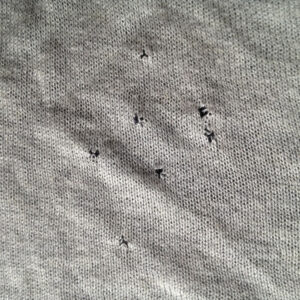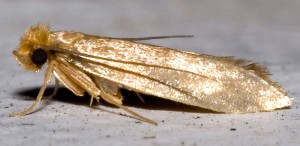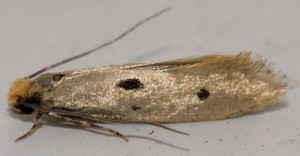Small holes in your clothes are one of the most common signs of a moth infestation - especially if your clothes are infested:
- has many holes
- has been tucked away for a while
- are made from an organic material such as wool, silk, feathers, fur, etc.
The holes are made by moth larvae, which feed on textiles from hatching to pupation. During this period, the larvae need a lot of nutrients to develop from larvae to adult moths in their pupae.
However, there can also be a number of other reasons why you get holes in your clothes - and in this article we have gathered all the possible causes of the phenomenon.
Are they moths?
There are several signs that can indicate that moths are the cause of the holes in your clothes:
Mothholes: If you are infested with moths, there will never be just one hole, but always several holes in your clothes (moths "pierce" your clothes). Moths also tend to attack only certain types of clothing, while other clothes that have been stored in the same area are completely undamaged.
Materials: Moths most commonly infest clothing made from materials of animal origin such as wool, silk, feathers, fur, etc. but clothes moths can also infest other types of fabric such as plastics, cotton, linen, etc. (especially if the textiles are unclean).
Hanging clothes: Moths attack especially clothes that are not used often and are hidden away in e.g. closets, drawers, boxes, bags, etc. It is not uncommon for clothes stored in basements, attics, etc. to be infested. Discarded work clothes, laundry, etc. are also good breeding grounds for moths because the clothes contain body oils that the moths absorb moisture from.
Other signs of moths
You can be sure the holes are caused by moths if you notice other signs of their presence - such as
- Spiders or pupae on clothing (or around clothing)
- Tits elsewhere in the home (e.g. on the ceiling or walls)
- Excrement on clothes (small whitish balls)
- Moth caterpillars (small whitish or yellowish caterpillars with dark heads)
- Adult moths in the home (either flying or running around)
You may not necessarily notice the adult moths, as some species are very shy and prefer to run rather than fly. This applies, for example, to clothes moths and fur moths, which are the most common moth species in Danish homes, but are also the species that attack clothes.
Moth eggs are almost never discovered as they are well hidden in folds of clothing, fur, etc. The eggs are also difficult to see with the naked eye. However, moth excrement is often mistaken for moth eggs.
Which moths are we talking about?
If the holes in your clothes are caused by moths, it's always one of these three moth species:
- Clothes moth (very likely)
- Fur moth (likely)
- Frog moth (less likely)
Be aware that holes in wool clothing can also be caused by clannerswhich are small beetles that can live in the home.
Especially the clothes moths (left) and fur moths (right) make small holes in clothes and other textiles
If the gaps are caused by clothes moths, they must be properly controlled. For this we recommend this clothes moth trap and these moth bags:
Other causes of holes in clothing
Although small holes in clothing are usually caused by moths, they can also have Other causes:
- Washing machines (especially older washing machines with minor defects)
- Tumble dryers
- Furnishings (especially countertops that you lean over can leave small holes in your clothes)
- Buttons (e.g. in pants)
- Zippers
- Seat belts
- Belts (especially belt buckles)
- Acidic foods (though these will make holes in wool clothing)
- Acid or other chemical agents
- Clanners (as mentioned above)
In addition, some clothing textiles are of such low quality that they quickly become holey or ripped. Damage to such garments can easily occur during normal use, washing, drying, etc.



